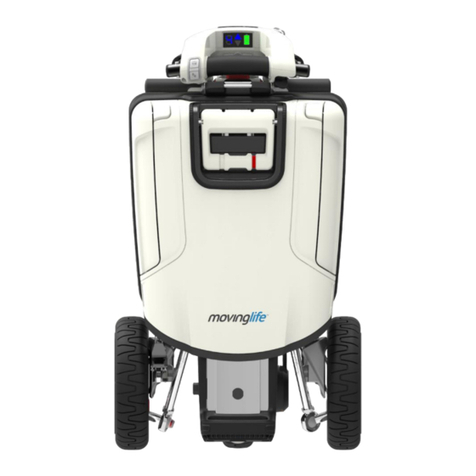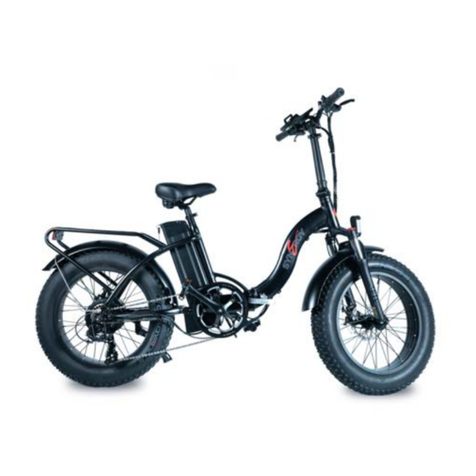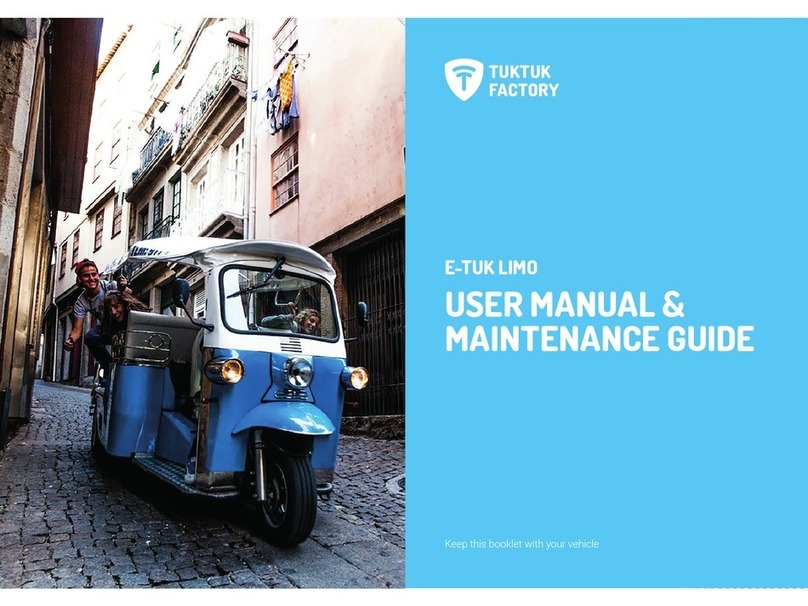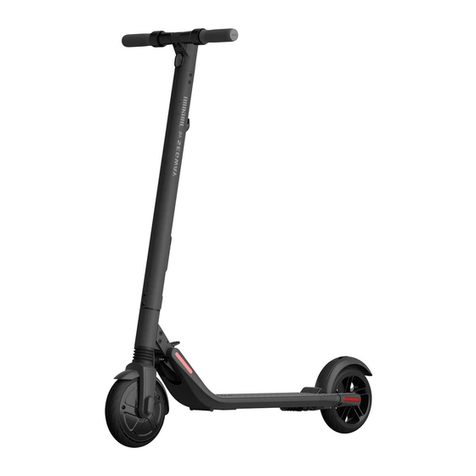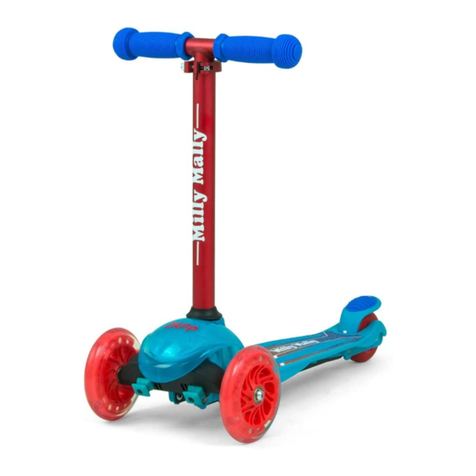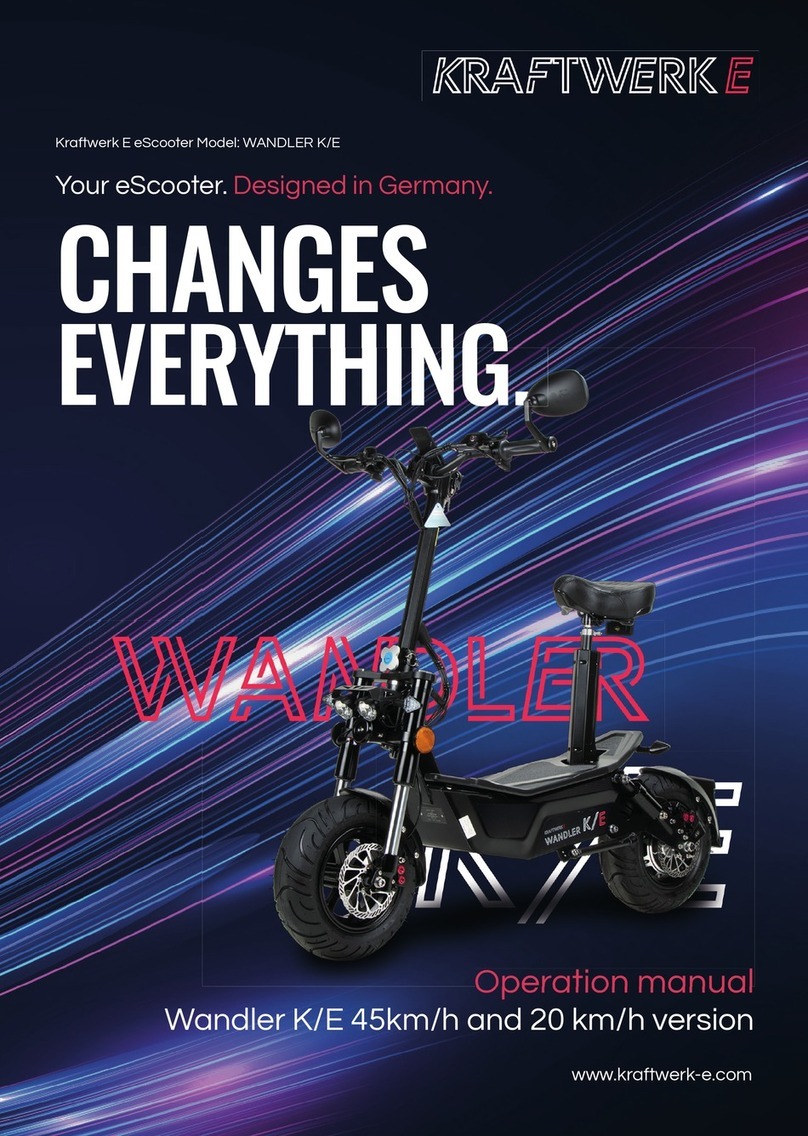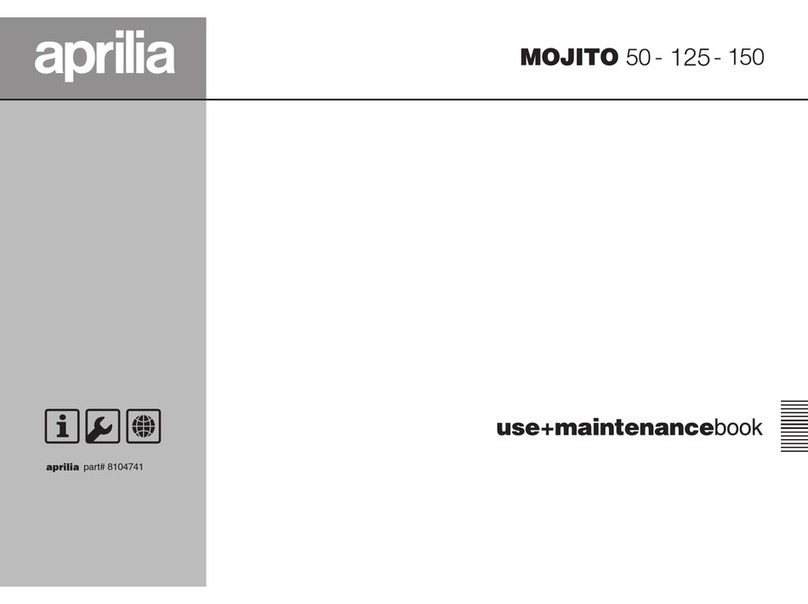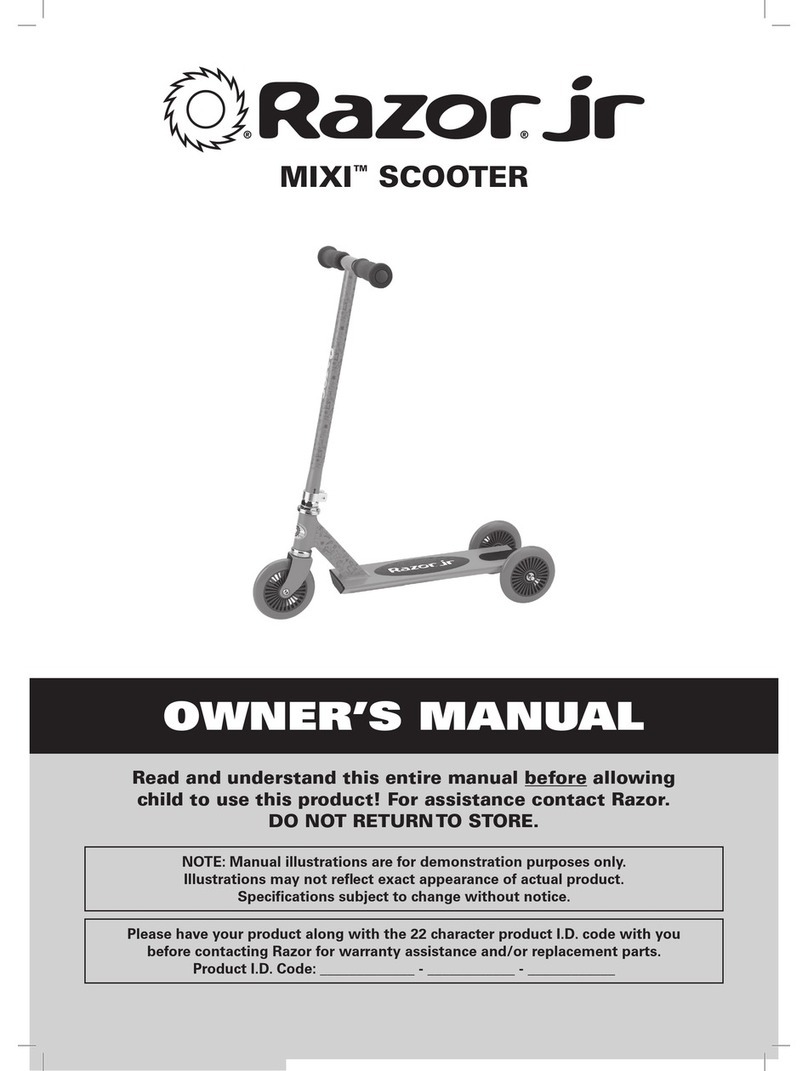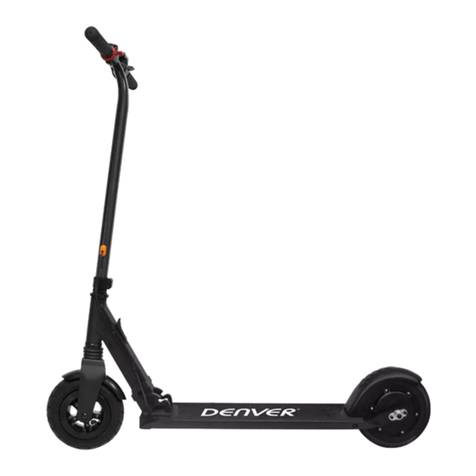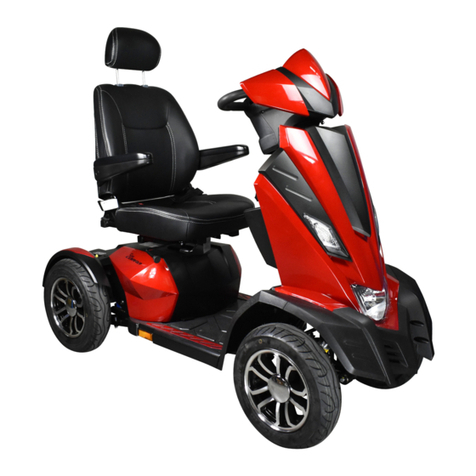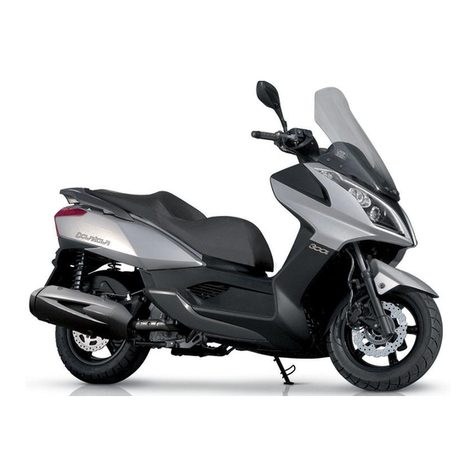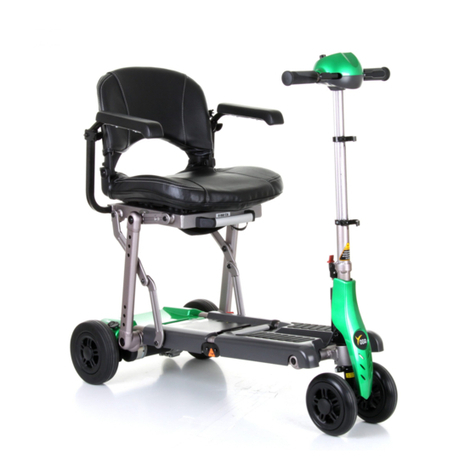movinglife ATTO User manual

Owner's Manual
www.movinglife.com


WELCOME
Movinglife Team are happy to welcome you to our family of ATTO users!
MovingLife’s mission is to produce topnotch superior quality products and provide supportive
services for the benet of mobility-limited users. Made by professionals and real users, ATTO is
handed to you knowing it will become not just another scooter but an extension of you and an
integral part of your life. As such, we have designed and manufactured each and every one of
ATTO’s 500 parts with great attention and care, which we know you will be able to appreciate.
However, no one is ever perfect and therefore, for the benet of both users and makers, we urge
you to contact us with any remark, idea for a change, complaint as well as just a complement.
We want to hear it all, so please register your ATTO and share with us your feedback using the
appropriate form on our website.
Enjoy your ATTO!
REGISTER NOW
Please visit MovingLife website and register your ATTO product. Once
registered you will become part of the MovingLife community, receive
safety notices and recall information and will be able to enjoy news,
updates, and special benets.
www.movinglife.com/register
PREFACE
Important Notice
This document is delivered subject to the
following conditions and restrictions:
• This Owner’s Manual contains proprietary
information of MovingLife Ltd. This
information is supplied solely for the
purpose of assisting authorized users of
MovingLife Ltd. products.
• This manual is designed to serve as an
accompanying document to the ATTO
Mobility Scooter.
• No part of the contents of this manual may
be used for any other purposes, disclosed
to any person or rm, or reproduced by any
means, without the express prior written
permission of MovingLife Ltd.
• The text and drawings in this manual
are for the purposes of illustration and
reference only. The specications on which
CAUTION
Federal law restricts this device to sale by
or on the order of a physician.
they are based are subject to change
without notice.
Trademarks
• ATTO is a registered trademark of
MovingLife Ltd.
• Other company and brand, product and
service names are for identication purposes
only and may be trademarks or registered
trademarks of their respective holders. Data
is subject to change without notice.
• This product is covered by MovingLife Ltd.
patents pending.

Indications for Use
• The MovingLife ATTO Mobility Scooter is
an indoor and outdoor mobility scooter that
provides transportation for a disabled or
elderly person.
Intended Users
• This motorized three-wheeled vehicle is
a battery-powered device intended for
medical purposes. It is used for both inside
and outside transportation.
• The ATTO is intended for people with
walking difculties or walking disability due
to an injury, a physical disability, old age, or
a medical condition.
• Intended users should assess eyesight, reaction
time, balance and posture, ability to sit for long
periods of time, concentration and ability to get
on and off the mobility scooter. Intended users
should be able to judge distances, recognize
obstacles and hazards, and be able to see
pedestrians and other road users.
• The intended user of ATTO is the occupant
who will be driving it and who may be aided
by an assistant for non-driving operations
such as opening and folding the mobility
scooter.
ABOUT THIS MANUAL
Purpose of this manual
This Owner Manual is an essential tool for
any user of a MovingLife ATTO. The manual
includes usage and operation guidelines,
warnings concerning dangers while operating
the ATTO including when changing from the
folded position to the drive position and vice
versa, while driving and during transportation
of the ATTO.
The purpose of the manual is to prepare you
and get you acquainted with the product and
NOTE
For information on opening the shipping
container and unboxing ATTO please
refer to the UNBOXING SUPPLEMENT
located in the container box.
all its capabilities. The manual is aimed at
providing you with all the answers to questions
that may arise during the operation and use
of the ATTO. If you encounter a question for
which you have not found an answer, please
contact a MovingLife dealer close to you or the
company's technical support via our website:
www.movinglife.com
Symbols and warning
Please pay attention to all warnings and
cautions in this Owner's Manual. They are here
to help you prevent injuries and damages that
may occur if you do not read or ignore the
instructions.
WARNING
WARNING frames include important
information concerning your safety and
warnings to prevent possible injuries.

In this Owner's Manual, you will also nd some
additional special symbols and warning as follows:
CAUTION
CAUTION frames are intended to draw
your attention to possible risks or damages
to your ATTO and other properties.
NOTE
NOTE: frames highlight some more
general information we would like you to
consider.
PINCH POINT
Pinch Point Warning: A pinch point
warning refers to an area where you must
pay extra attention to your ngers, so as
to be sure your ngers are not pinched
between two metal parts.
REQUIRES TOOLS
Wrench Warning: If you see a warning
with a wrench symbol and you are not
a certied technician please ignore the
instructions and seek a professional, or
contact MovingLife support to help you
locate a professional close to you.
Users & certified technicians
WARNING
THIS CLAUSE CONTAINS MUST-READ
INFORMATION CONCERNING USERS
AND CERTIFIED TECHNICIANS.
This Owner's Manual contains important
information for the safe operation and use
of this product. DO NOT use this product or
any available optional equipment without rst
reading and completely understanding these
instructions and any additional instructional
material supplied with this product or optional
equipment. If you are unable to understand
the warnings, cautions or instructions, contact
a healthcare professional, an authorized
MovingLife dealer or technical personnel
before attempting to use this equipment –
otherwise, injury or damage may occur.
NOTE
This Owner’s Manual is compiled from
the latest specications and product
information available at the time of
publication. We reserve the right to make
changes as they become necessary or
available. Any changes to our products
may result in slight variations between
the illustrations and explanations in
this manual and the product you have
purchased.
ATTO Users: do not service or operate
this equipment without rst reading and
understanding this Owner's Manual. If you are
unable to understand the warnings, cautions,
and instructions, contact MovingLife technical
support before attempting to service or
operate this equipment – otherwise injury
or damage may result. Procedures other
than those described in this manual must be
performed by a qualied technician.
MovingLife Qualied Technicians: do not
service or operate this equipment without
rst reading and understanding the Owner's
Manual and service manual. If you are unable
to understand the warnings, cautions and
instructions, contact MovingLife technical
support before attempting to service or
operate this equipment – otherwise, injury or
damage may result.

BACKGROUND
MovingLife's ATTO is an advanced-technology
Class A mobility scooter, designed for use
indoors and on outdoors. When driving on a
sidewalk you should always follow pedestrian
rules. You should give pedestrians priority and
show consideration for other sidewalk users,
particularly those with a hearing or visual
impairment who may not be aware of your
presence on a mobility scooter.
In most countries, mobility scooters may
only be used by a disabled person, or by a
nondisabled person demonstrating a vehicle
before sale, training a disabled user or taking
the vehicle to or from maintenance or repair.
A disabled person in this context is someone
with an injury, physical disability, or medical
condition which means that they are unable
to walk or have difculty walking.If you are
using a mobility vehicle for the rst time, or if
it has been a while since you have driven one,
you are strongly advised to get some training
to ensure that you can steer and control
the vehicle properly, especially on uneven
surfaces. Your assessment should include
checking your eyesight, reaction time, balance
and posture, ability to sit for long periods of
time, concentration and ability to get on and
off the ATTO. You may also want to consider
having a regular review of your driving skills.
Although in most countries there are no
legal eyesight requirements, good vision
is important for driving a mobility vehicle
safely. You should be able to judge distances,
recognize obstacles and hazards, and be able
to see pedestrians and other road users. Poor
eyesight could be a contributory factor in an
accident and could render you liable for a
compensation claim. Vision can change with
age and you are recommended to have regular
sight tests.
If you are eligible to be registered as severely
sight impaired (blind), you should not drive a
mobility scooter as this would put yourself and
others at risk.
If you are eligible to be registered as sight
impaired (partially sighted), you should consult
your optometrist or doctor.
If you regularly take medication that makes
you drowsy, you should consider whether it
would be safe to use a mobility scooter. If you
are in any doubt, consult your doctor. You
should not use a mobility scooter if you have
been drinking alcohol.
ATTO can be used in pedestrian areas;
on footpaths, pavements, sidewalks and
bridleways. It can be used on the road if
a pavement is not available, or where it is
necessary to cross the road.
Subject to space availability and depending
on local regulations, you may be able to travel
with your ATTO on buses and trains, so long
as those vehicles are constructed or adapted
to carry a mobility scooter, and providing that
ATTO ts on board.
NOTE
Laws and regulation may vary from
country to country and from state to
state. Always check with local authorities
to ensure that you can use your mobility
scooter and that you understand the
local restrictions that apply to you and
your ATTO.

Certification and Compliance
The ATTO Mobility Scooter is designed to
comply with the following international safety
requirements for medical electrical equipment:
Safety:
EN 12184 and ISO 7176-15
EMC: ISO 7176-21
Risk Management: ISO 14971
Regulatory Compliance: EEC: Annex V of
93/42/EEC
The European Medical Devices Directive
of 93/42/EEC classies the ATTO Mobility
Scooter as a Class I device
Device cleared by FDA : K160909
SAFETY
Safety highlights
ATTO is not a toy and should
not be used by children,
unless they are the intended
users who comply with laws
and regulations and with
the minimum requirements
specied in the specication
section of this Owner's Manual.
ATTO is not intended for show-
off driving or any other use
other than the intended use.
This mobility scooter must be
used only in areas intended
for pedestrians and under
conditions allowing safe use and
good contact with the ground.
Beware of snow, ice, sleet,
rain, strong wind, sand, broken
glass and other obstacles and
interferences. All those and
other such irregularities are
dangerous to you and to others
and should be avoided to
prevent injury and damage.
Do not try to descend or climb
an incline with an angle greater
than recommended. See the
“Specications” section of this
Owner's Manual.
Always climb or descend an
incline by driving straight up or
straight down the incline.

Safety and usage instructions
DISCLAIMER: MovingLife Ltd. is not and cannot
be held responsible for any damage or injury
incurred due to improper or unsafe use of the
MovingLife's ATTO. MovingLife Ltd. specically
disclaims responsibility for any bodily injury or
property damage that may occur during any use
that does not comply with applicable federal,
state, or local laws or ordinances.
WARNING
Carefully read and adhere to the
following safety instructions.
CAUTION
FIRST TIME USER – Do not operate your
ATTO for the rst time before reading
and completely understanding this
Owner's Manual.
First time users
• Do not use this product or any available
optional equipment without rst reading and
completely understanding these instructions.
If you are unable to understand the
warnings, cautions or instructions, contact
a healthcare professional, an authorized
MovingLife dealer or MovingLife technical
support before attempting to use this
equipment, otherwise, injury or damage may
occur.
• There are certain situations, including some
medical conditions, where the ATTO user
will have to practice operating the ATTO
in the presence of a trained attendant. A
trained attendant can be dened as a family
member or care professional especially
trained in assisting an ATTO user in various
daily living activities. Consult your physician
if you are taking any medication that may
affect your ability to operate your ATTO safely.
• If you feel uncomfortable with your new
ATTO or do not understand the instructions
presented in this Owner's Manual, or if,
for any reason, you do not feel capable of
performing the activities necessary to open,
fold, assemble, disassemble, operate, or
maintain your ATTO, please contact the
authorized MovingLife dealer from whom
you purchased your ATTO, or contact
MovingLife technical support.
General
• Always turn the power off when the unit is
not in use.
• Always make sure your seat is locked in fully
opened position before driving your ATTO.
• Always remain properly seated when
operating your ATTO.
• Use caution when driving on soft or uneven
surfaces such as grass and gravel.
• Use caution on decks where there is no railing.
• Turning too sharply around a corner can
cause the ATTO to tip over. Avoid this
danger at all times by steering a wide arc
around corners and obstacles. To avoid the
risk of tipping over, reduce speed before
negotiating any turns.
• For emergency stop, press the On/Off
button.
• Never attempt to drive over or off obstacles
higher than 20 mm (3/4”) when driving
forward and 18 mm (45/64”) when driving
in reverse. This could be unsafe and could
damage the ATTO.
• Avoid turning off the power while the ATTO
is moving. Doing so will cause the ATTO to
come to an abrupt stop.
• Avoid reaching or bending while driving
your ATTO. Bending forward creates the risk
of accidental throttle lever contact. Bending
sideways while seated creates the risk of
tipping over. It is important to maintain a

stable center of gravity and keep the ATTO
from tipping over.
Driving in public
• Do not ride your ATTO in trafc, on public
streets and roadways.
• Be aware that it may be difcult for trafc to
see you when you are seated on the ATTO.
Obey all local pedestrian and trafc rules.
Wait until your path is clear of trafc, and
then proceed with extreme caution.
• If the power button is switched off while
driving on horizontal level plane at maximum
speed (Limited by software) of 6.4 km/h (4
mph), it will come to a stop with a maximum
stopping distance of 1.1 m (about 4 ft).
Please consider this distance when driving.
• Do not attempt to use your ATTO on stairs
or escalators. Always use an elevator.
• Do not operate your ATTO where one could
not safely or legally walk.
• Never operate your ATTO near steps or
curbs where one might accidentally drop a
wheel off the edge.
• Enter narrow driving paths/doorways slowly
and with caution. Always look out for
additional obstacles such as car mirrors or
doorknobs.
Sharp turns
• Avoid sudden starts while the handlebar is
turned sharply.
• Do not make a sharp turn or a sudden stop
while riding your ATTO.
• Always reduce your speed and maintain a
stable center of gravity when turning a sharp
corner. Do not turn corners sharply when
driving at higher speeds.
• Always reduce the speed of your ATTO
when making turns.
Driving angles
• Do not attempt to climb ramps, slopes,
curbs, or any low-rise slope with an angle
greater than the limits specied in the
Technical Specication.
• When climbing an incline, do not drive at
an angle to the incline. Drive your ATTO
straight up the incline. This greatly reduces
the risk of tipping over or falling.
• For maximum stability, lean forward on your
seat while proceeding up ramps, slopes,
curbs, or any low rise.
• Drive with caution when attempting to
negotiate any incline, even handicap access
ramps.
• Do not traverse or drive across the face of a
slope.
• Do not attempt to negotiate an incline that
is covered with snow, ice, cut or wet grass,
leaves, or any other potentially hazardous
material.
• Try to keep your ATTO moving when
climbing an incline. If you do come to a
stop, restart and accelerate slowly and
carefully.
• While you are driving down a slope, if your
ATTO starts to move faster than you feel is
safe, release the thumb lever and allow your
ATTO to come to a stop. When you feel that
you have gained control of your ATTO again,
press the thumb lever and continue safely
down the remainder of the slope.
• Do not place your ATTO in freewheel mode
when on an incline or decline.
• Never park on inclines or declines.
• If you must stop on an incline, always
lean forward to shift the center of gravity
and prevent the ATTO from tipping over
backwards.

Reversing
• Make sure that there are no obstacles
behind you while reversing your ATTO.
• Do not attempt to have your ATTO move
backward down any step, curb or other
obstacle. This may cause the ATTO to fall or
tip over.
• Arms and legs
• When getting on or off your ATTO, do not
put most or all of your weight on the edge
of the deck. Doing so may cause the ATTO
to tip over.
• Do not extend your hands and legs off the
ATTO when driving.
• Keep your hands and legs away from the
wheels while driving the ATTO. Be aware
that loose tting clothing may get caught in
moving parts.
• Always keep your legs on the feet pads
while you are seated on your ATTO.
Weather
• Do not operate or store your ATTO where
it will be exposed to rain, snow, mist, or
anywhere that reaches below freezing
temperature.
• Do not operate your ATTO during stormy
weather to reduce the risk of an accident or
possible damage to the ATTO.
• Operating in rainy, snowy, salty, misty
conditions and on icy or slippery surfaces
may have an adverse effect on the electrical
system.
• The temperature of ATTO surfaces that can
come into direct contact with the driver
and/or assistant’s skin during normal use
and which are within the driver’s reach shall
not exceed 410C. The motor surface can
reach temperatures greater than 410C
after driving. Do not touch these parts when
folding or unfolding the ATTO or wait until
the motor has cooled down.
• Do not touch the motor when folding or
unfolding the ATTO, until the motor has
cooled down.
• Do not hose down your ATTO.
• Maintain and store ATTO in a clean and dry
condition and avoid exposure to rain, snow,
ice, salt, or standing water.
Power off
• To prevent injury to yourself or others,
always ensure that the power is switched off
when getting on or off the ATTO.
Freewheel
• For information on setting the ATTO in
Freewheel mode see the “Operating the
freewheel” section in this manual.
• Always check that the front wheel is
engaged (not in freewheel mode) before
driving. Do not switch off the power when
the ATTO is still moving forward. This will
bring the ATTO to a very abrupt stop.
• Be aware when the drive wheel is unlocked
(freewheel mode) or locked (driving mode).
• The drive-wheel has to be switched to
engaged-mode (not in freewheel mode)
while transporting the ATTO. For instruction
see the Freewheel section on page .
• Never sit on your ATTO when it is in
freewheel mode.
Lifting
• Do not attempt to lift or move your ATTO
by any of its removable parts including the
seat or driving console. Personal injury and
damage to the ATTO may result.
Load
• Never use the ATTO to carry or tow, push or
pull anything but yourself.
• You may use dedicated accessories
approved by MovingLife to carry shopping

bags and a small luggage only if done
according to instructions and only if the
combined weight of the passenger plus
load does not exceed the maximum allowed
weight of the ATTO.
Medical condition
• Never operate the ATTO while you are
under the inuence of alcohol.
• Never operate the ATTO if your health
condition or medications you are taking
cause you to feel dizzy, affect your vision, or
affect your ability to safely operate the ATTO
in any other way.
• Consult your physician if you are taking
prescribed medication or if you have any
physical limitations. Some medications and
limitations may impair your ability to operate
the ATTO in a safe manner.
External devices
• Contact with tools can cause electrical shock.
• Do not connect or allow anyone except an
authorized MovingLife representative to
connect any electrical or mechanical device
to your ATTO. Unauthorized accessories will
void the warranty and may cause damage or
injury.
Unusual usage
• Never try to use your ATTO beyond its
limitations as detailed in this Owner's
Manual.
• Never sit on your ATTO while it is in a
moving vehicle.
• Never sit on your ATTO when it is being
used in connection with any type of lift
or elevation product. Your ATTO is not
designed with such use in mind and
MovingLife shall not be liable for any
damage or injury incurred from such use.
• Programming of the controller shall only
be carried out by authorized personnel.
Incorrect programming can result in safety
hazards for the driver.
Battery and charger
• Do not allow unsupervised children to play
near this equipment while the batteries are
charging.
• Never charge a frozen battery.
• If you encounter a damaged or cracked
battery, immediately enclose it in a plastic
bag and call your authorized MovingLife
dealer for recycle and disposal instructions.
• Always avoid/prevent damage to AC and DC
cords.
• Do not connect an extension cord to the
battery charger.
• Use only original MovingLife Li-Ion battery.
Modifications
WARNING
This product has been designed and
engineered to provide maximum utility.
However, under no circumstances should
you modify, add, remove, or disable any
part or function of your ATTO. Personal
injury and damage to the ATTO may
result.
1. Do not modify your ATTO in any way
not authorized by MovingLife.
2. Do not use accessories if they have not
been tested or approved by MovingLife.
3. Get to know the feel of your ATTO and
its capabilities. We recommend that you
perform a safety check before each use
to make sure your ATTO operates safely.

Weight limitation
WARNING
1. Please refer to the specications table
for weight capacity information.
2. Keep within the specied weight
capacity for your ATTO. Exceeding the
weight capacity voids your warranty. The
manufacturer will not be held responsible
for injuries or property damage resulting
due to failure to observe weight
limitations.
3. Do not carry passengers on the ATTO.
Carrying passengers on the ATTO may
affect the center of gravity, resulting in
tipping over or a falling.
WARNING
1. Some of the parts of the ATTO are
susceptible to change in temperature.
The controller can only operate in
temperature that ranges between minus
20°C and plus 50°C.
2. At extreme low temperatures the
batteries may freeze, and your ATTO
may not operate. In extreme high
temperatures it may operate at slower
speeds due to a safety feature of the
controller, which prevents damage to the
motors and other electrical components.
3. ATTO surfaces temperatures can
increase or decrease when exposed to
external sources of heat or cold (e.g.
sunlight, outdoor environment).
Temperature Safety labels
The following safety symbols are used on
ATTO to identify warnings, mandatory actions
and prohibited actions. It is very important that
you read and understand them completely.
Place unit on level
ground when changing
from “D” drive mode
to “N” freewheel mode
or freewheel mode to
drive mode.
N = Unlocked /
freewheel.
D = Locked / drive
mode specied in the
specication section of
this Owner's Manual.
Marked handle is not
intended for product
lifting.
Marked handle must not
be used while ATTO is
in opened position.
ATTO may topple when
not in parking mode.
Indicates front module
weight in kilograms.
Do not lift marked
handle while seated
on ATTO.

Indicate ATTO's
maximum user
weight capacity.
Reduce speed to
minimum when
approaching an incline
or a turn.
Avoid ascending or
descending ramps,
curbs or slopes greater
than 6 Deg.
Avoid sharp turns or
sudden stops.
Pinch/Crush points
created during the
operation of ATTO
(opening, closing,
assembly, & disassembly).
Indicates ATTO's
maximum user weight
capacity. Indicates rear
module weight in
kilograms.
Damaged labels
In case labels are unreadable for any reason,
please consult this chapter and contact
MovingLife for a new set of labels free of
charge.
Compliance and Warning Labels
The ATTO Mobility Scooter system
components are equipped with various
product compliance labels and icons. These
are strategically positioned to provide
important information regarding safe operation
of the system.
For a description of the labels and symbols
used as well as details of their location, refer to
the following:
• Safety Rating and Manufacturer Identication
Label on page 78.
• Symbols and Descriptions on pages -24.
NOTE: Additional labels used on system
controls, accessories and disposables are
illustrated and described in the following
sections:
• Labels on ATTO Mobility Scooter Controls
on page.
EMC information
WARNING
It is very important that you read this
information regarding the possible effects of
electromagnetic interference on your ATTO.
Electromagnetic Interference (EMI)
from radio wave sources
Mobility scooters may be susceptible to
electromagnetic interference (EMI), which
is interfering electromagnetic energy (EM)
emitted from sources such as radio stations,
TV stations, amateur radio (HAM) transmitters,
two-way radios, and cellular phones. The
interference (from radio wave sources) can
cause the mobility scooter to release its
brakes, move by itself, or move in unintended
directions. It can also permanently damage the
mobility scooter control system. The intensity
of the interfering EM energy can be measured
in volts per meter (V/m).
Each mobility scooter can resist EMI up
to a certain intensity. This is called the
"EMI immunity level". The higher the EMI
immunity level, the greater the protection
from EMI. Currently the ATTO technology has

an mmunity level of at least 20 V/m, which
provides useful protection from the more
common sources of EMI.
There are a number of sources of relatively
intense electromagnetic elds in the daily
environment. Some of these sources are
obvious and easy to avoid. Others are not
apparent, and exposure is unavoidable.
However, we believe that by following the
warning listed below, your risk to EMI will be
minimized.
The sources of radiated EMI can be broadly
classied into three types:
1. Hand-held portable transceivers. These
are transmitters-receivers with the antenna
mounted directly on the transmitting unit.
These devices include citizens band (CB)
radios, walkie-talkies, security, re and police
transceivers, cellular telephones, and other
personal communication devices).
NOTE: Some cellular telephones and similar
devices transmit signals while they are on, even
when not being used.
2. Medium-range mobile transceivers, such
as those used in police cars, re trucks,
ambulances and taxis. These usually have
the antenna mounted on the outside of the
vehicle.
3. Long-range transmitters and transceivers,
such as commercial broadcast transmitters
(radio and TV broadcast antenna towers) and
amateur (HAM) radios.
NOTE: Other types of hand-held devices, such
as cordless phones, laptop computers, AM/FM
radios, TV sets, CD players, cassette players,
and small appliances such as electric shavers
and hair dryers are not likely to cause EMI
problems for your ATTO, as far as we know.
Mobility Scooter Electromagnetic
Interference (EMI)
Because EM energy rapidly becomes more
intense as one moves closer to the transmitting
antenna (source), the EM elds from hand-held
radio wave sources (transceivers) are of special
concern. It is possible to unintentionally bring
high levels of EM energy very close to the
mobility scooter control system while using
these devices. This can affect the mobility
scooter movement and braking.
Therefore, the warnings listed below are
intended to prevent possible interference
with the control system of the ATTO.
Electromagnetic interference (EMI) from
sources such as radio and TV stations, amateur
radio (HAM) transmitters, two-way radios, and
cellular phones can affect mobility scooters.
WARNING
Following the warnings listed below
should reduce the chance of unintended
brake release or scooter movement,
which could result in serious injury.
1. Exercise caution when using hand-held
transceivers (transmitters receivers), such as
citizens band (CB) radios, or turn on personal
communication devices such as cellular phones
while the ATTO is turned ON;
2. Be aware of nearby transmitters, such as
radio or TV stations, and try to avoid going
close to them;
3. If unintended movement or brake release
occurs, turn the ATTO OFF as soon as it is
safe;
4. Be aware that adding accessories or
components, or modifying the ATTO, may

make it more susceptible to EMI (NOTE: There
is no easy way to evaluate their effect on the
overall EMI immunity of the ATTO);
5. Report all incidents of unintended movement
or brake release to the ATTO manufacturer and
note whether there is a source of EMI nearby
Important
EMI/RFI – ATTO has passed an EMI immunity
test according to EN 60601-1 Class B.
Modication of any kind to the electronics of
the ATTO as manufactured by MovingLife may
adversely affect the EMI immunity levels.
Radiation
The ATTO Mobility Scooter does not generate
any hazardous radiation.
WARNING
The operation of the ATTO might disturb the
operation of devices in its environment due to
emitting of electromagnetic elds (e.g. alarm
systems of shops, automatic doors, etc.).
ATTONOMY
Figure 1 - ATTO in folded mode

ATTONOMY
Figure 2 - ATTO in driving mode
ATTONOMY
Figure 3 – ATTO in trolley mode

OPERATING ATTO
ATTO is very easy to operate; it requires
no special skills. Learn how to operate your
ATTO by following the steps described in the
following pages and by practicing.
The rst step is to read through this chapter
of the Owner's Manual and understand the
sequence of steps required for opening and
closing (folding) the ATTO. Once completed,
use the manual to guide you while you
practice each step. It may be difcult at rst
but it will become very easy once you have
practiced it several times.
To support easy visual learning we have
created a simple video, which is available to
watch under the videos section of our website:
www.movinglife.com/videos
Opening
1. Position your ATTO is on a at surface
before opening. Make sure you have clearance
of 2 meters (7 feet) from the side of the back
wheels.
WARNING
Injury hazard due to improper assembly,
disassembly, opening or closing ATTO.
Ensure that all components in the ATTO
have been correctly placed before
continuing to the next step. Always check
that all locked devices are safely secured.
PINCH POINT
Operations described below are done near
and around pinching points. Be careful and
follow instructions to prevent injury. Make sure
your ngers are distanced from moving parts
that may be closing gaps while in movement.
2. Release the adjustment lever of the
handlebar (1) and bring the handlebar to an
upright position (2), then bring the lever back
to its secured position (3) (see Figure 4).
Figure 4
3. Press the central release button until it clicks
and remains pressed down (see Figure 5).
Figure 5
4. Press the rod button (1) and tilt it away from
the main ATTO body (2) (see Figure 6).
Figure 6
5. Hold ATTO by both the main handle and
the handlebar (see Figure 7).
Figure 7

6. Tilt ATTO toward the rod until the front
wheel touches the ground (see Figure 8).
Figure 8
7. Using the main handle, pull the main body
away from the rod, thus rolling the back wheels
away from the front wheel (see Figure 9).
Figure 9
8. Gently move the handle down until ATTO’s
base is at (see Figure 10).
Figure 10
9. Place handle in its designated place (see
Figure 11).
Figure 11
NOTE
Keep holding the rod at upright position.
10. Lock the rod in upright position by pushing
the front lever down until it clicks and locks
in place (1) (see Figure 12). In case the front
lever requires too much force to operate, you
should apply horizontal pressure on the main
handle towards the front of the ATTO (2). This
will release the pressure on the front lever and
will make it easier to lock (3).
Figure 12
11. Place one hand on the tiller and with the
other hand release the secure lever of the
back handle (1), bring the handle to an upright
position of 90 degrees (2) (see Figure 13).
Figure 13
NOTE
For proper operation please do not ip
the handle to 180 degrees from closed
position. If you did and you are unable to
lift the chair backwards, return the handle
to its original position and try again.

Using the handle, pull the back of the chair
backwards until it clicks and locks in place (see
Figure 14).
Figure 14
12. Continue using the handle to pull up the chair
until it clicks and locks in place (see Figure 15).
Figure 15
13. Open both sides of the handlebar (see
Figure 16).
Figure 16
WARNING
Do not sit on the chair before it clicks
into place, to prevent it from sliding
down again.
Removing the battery
Identify the battery release button (see
highlighted in red in Figure 18).
Figure 18 - battery release button
To remove the battery from ATTO, press the
release button (1) and pull the battery out (2)
(see Figure 19).
Figure 19
Installing the battery
To install the battery, insert rst the back end
of the battery (1) and then push the front until
the battery clicks and locks in place (2) (See
Figure 17).
Figure 17
NOTE
Make sure the battery is properly
connected before folding ATTO or
turning it on.

Use the handle for carrying the battery when is
has been removed from ATTO (see Figure 20).
Figure 20
WARNING
• NEVER attempt to recharge the
batteries by attaching cables directly
to the battery terminals.
• DO NOT attempt to recharge the
battery and operate ATTO at the
same time.
• DO NOT attempt to recharge
the battery when ATTO has been
exposed to any type of moisture.
• DO NOT attempt to recharge the
battery when ATTO is outside.
• DO NOT sit on ATTO while
recharging the battery.
WARNING
• A new battery MUST be fully charged
prior to initial use of ATTO. ALWAYS
fully charge a new battery before
initial use or your battery life will be
reduced.
• As a general rule, you should charge
your battery at 60% of full charge
before placing in storage for any long
period of time.
• Only use a charger approved by
MovingLife.
• Use of improper extension cord for the
charger could result in risk of re and
electric shock.
Charging the battery can be done on board
and off board. This means that you can connect
the charger when the battery is attached to the
ATTO or when it is detached from the ATTO.
Adjusting for maximum comfort
Several adjustments can be made for
maximum comfort. Some adjustments can
be made by the user, while other adjustments
must only be made by a certied technician.
The adjustments that can be made by the user
are specied in detail in this section.
Figure 21 Comfort adjustments
PINCH POINT
Operations described below are done
near and around pinching points. Be
careful and follow instructions to prevent
injury. Make sure your ngers are
distanced from moving parts that may be
closing gaps while in movement.
Adjusting Driving Console height
Open the rod lever and hold it (1) while you
adjust the height of the handlebar to your
preferred level (2). Bring the lever back to
the secure position once you're done (3) (see
Figure 22).
Figure 22 Driving Console height lever
Other manuals for ATTO
4
Table of contents
Other movinglife Scooter manuals

